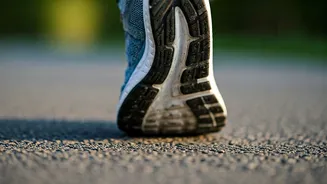Muscle Strengthening Revealed
Reverse walking provides a unique and effective way to strengthen various muscle groups, especially those often neglected during forward walking. By walking backward,
you engage muscles differently, promoting better balance and coordination. This method targets the quadriceps, hamstrings, and calf muscles in a way that regular walking doesn't. Furthermore, the unfamiliar movement challenges your body, leading to increased muscle activation and overall strength gains. The constant adjustments required to maintain balance while reverse walking enhance core stability, contributing to better posture and reduced risk of injury. Regular practice can lead to a more balanced and robust physique, making everyday activities easier and more enjoyable. Think of it as a low-impact workout that's gentle on your joints but tough on your muscles. It's a simple, yet highly effective way to build strength and improve physical performance.
Joint Health Enhancement
Reverse walking offers significant advantages for joint health, serving as a gentle yet effective form of exercise. The unique mechanics of walking backward place less stress on the knees and ankles compared to forward walking. This reduced impact is particularly beneficial for individuals with joint pain, arthritis, or those recovering from injuries. The controlled movements during reverse walking help to lubricate the joints, improving flexibility and range of motion. It can also help to strengthen the muscles that support and stabilize the joints, further reducing the risk of injury. Moreover, the increased awareness required during reverse walking can help improve proprioception, the body's ability to sense its position in space, which is crucial for maintaining balance and preventing falls. By incorporating reverse walking into your routine, you can promote healthier, more resilient joints and improve your overall mobility, making it a valuable practice for people of all ages and fitness levels.
Heart Health Boost
Reverse walking has a positive impact on cardiovascular health. It increases heart rate and improves blood circulation more efficiently than regular walking, offering a moderate-intensity workout. The increased effort required to walk backward boosts your cardiovascular fitness, helping to strengthen the heart muscle and improve its efficiency. This can lead to a lower resting heart rate and reduced blood pressure, lowering the risk of heart disease. Furthermore, reverse walking can improve the function of blood vessels, enhancing the delivery of oxygen and nutrients to the muscles and organs. Regular practice can also help to improve cholesterol levels, contributing to overall cardiovascular health. By incorporating reverse walking into your routine, you can promote a healthier heart and reduce your risk of serious health conditions. It’s a simple, yet effective way to get your heart pumping and improve your overall well-being.
Cognitive Function Improvement
The benefits of reverse walking extend beyond the physical realm, positively impacting cognitive function. The unfamiliar nature of reverse walking requires increased mental focus and coordination, stimulating the brain and enhancing cognitive abilities. This practice challenges your brain to process information differently, improving memory, attention, and spatial awareness. The increased blood flow to the brain during exercise further supports cognitive function. Studies have shown that regular physical activity, including reverse walking, can improve cognitive performance, particularly in areas related to executive function, such as planning and decision-making. By incorporating this exercise into your routine, you can sharpen your mental acuity, improve focus, and enhance your overall cognitive health. It’s a simple way to give your brain a workout while enjoying the physical benefits of walking.
Simple Practice Tips
Starting a reverse walking routine is simple, but it is important to begin with caution. Begin on a flat, even surface, free from obstacles. Initially, start with short intervals of one to two minutes, gradually increasing the duration as you become more comfortable. Maintain a slow and controlled pace to avoid falls, and focus on maintaining good posture by keeping your back straight and your eyes forward. If you feel dizzy or unstable, immediately stop and rest. It is always wise to begin slowly and gradually increase the intensity and duration of your reverse walking sessions. Consider wearing supportive footwear and, if needed, use a walking stick or a friend for support, especially when first starting out. Listen to your body and adjust your pace as needed. Regular practice will improve your balance, coordination, and overall fitness levels, making reverse walking a safe and enjoyable exercise for people of all ages and fitness levels. Consistency is key to reaping the maximum benefits from this simple, yet powerful exercise.












